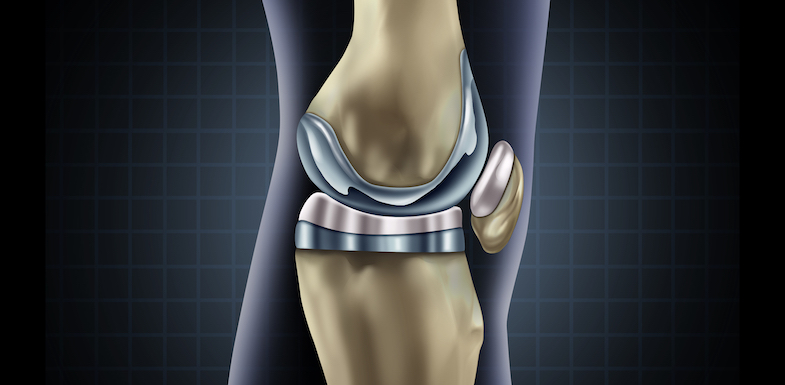Knee pain can appear in many forms. Arthritis, an injury, and gradual wear and tear as you age can all have an effect on your activities and comfort level. If you’re unable to walk or climb a stairs because of your pain (and have tried several non-invasive methods to find relief), knee replacement surgery may be the best way to get your life back. While the benefits of the procedure may significantly outweigh temporary discomfort, it’s important to have realistic expectations regarding your recovery timeline and knee replacement pain after surgery.
What does knee replacement surgery recovery look like?
During knee replacement surgery, your doctor will make an incision before moving your knee cap and cutting away any damaged bone, cartilage, and joint surfaces. Artificial joints will then be attached and tested by bending and rotating your knee before your doctor closes your incision with stitches.
Whether you’re having a total or partial knee replacement will have an effect on your pain level and recovery.
A traditional total knee replacement will typically require one to three months of recovery with the use of a walker or a cane. On the other hand, a partial knee replacement is much less invasive. Patients usually walk without assistance within two weeks. This is because the incision is much smaller and there is significantly less blood loss. While this may sound more appealing than a total knee replacement, only about 10% of patients are good candidates for a partial knee replacement procedure.
After your surgery, you’ll follow weight-bearing guidelines. How much pressure your new knee can initially support will depend on the condition of your natural bone, as well as the type of prosthesis you have.
Also note that every patient heals at a different pace. Practicing knee-strengthening exercises before surgery can help you recover more quickly, but an elderly patient, smoker, or someone who suffers from other medical conditions may take longer to heal. Talk to your doctor about your medical history to gain a better understanding of what to expect from your personal recovery journey. Always follow their directions exactly for recovery.
What causes pain after knee replacement surgery?
Researchers continue to study the many causes of pain after knee replacement surgery. Some are biological and due to conditions present before surgery, while others are due to complications that arise during surgery.
On the biological side, patients suffering from arthritis may experience increased sensitivity because of the ongoing pain that was present before surgery. As we’ll explain below, inflammatory responses and allergy-related problems can also contribute to persistent pain. Another source of pain is referred pain originating from the hip due to a change in alignment.
If you are experiencing ongoing pain after knee replacement surgery, but do not have a medical history of arthritis or the previously mentioned issues, you may be dealing with surgical complications. While your doctor will take steps to prevent problems, it’s still possible for these to rare issues to occur:
- Infection
- Nerve injury
- Prosthetic loosening
- Poor alignment or rotation
- Incorrect sizing
- Instability
- Stiffness
Remember to stay open and honest with your doctors. This will help them properly diagnose and treat the problem to get you the pain relief you’re looking for.
Where will I feel knee replacement pain?
As mentioned above, knee replacement pain can come in many different forms depending on the cause. Knee pain is to be expected due to the surgical procedure itself, with swelling, bruising, and the introduction of prosthetic parts.
Beyond that, it is possible to feel pain in parts of the body other than your knee. This is known as referred pain.
Your hips, lower back, groin area, and calves may initially hurt due to the change in your stance and the way you walk. Of course, it is also typical to feel sore due to extended amounts of time in bed during your recovery.
Knee replacement pain: The week following surgery
You should expect to stay in the hospital for several days following knee replacement surgery. This is often considered the most painful stage of the recovery process. Your doctor will prescribe medications to help you manage your pain level.
In addition to icing your knee, you may be encouraged to move your foot and ankle to increase blood flow and lower the risk of swelling and blood clots. Your doctor may also use blood thinners, support hose, and compression boots to prevent further complications.
Generally the day after surgery, a physical therapist will show you exercises that will help you recover your range of motion and continue to heal. You may even be asked to get up and take a few steps (with assistance). Patients who get up and put a safe amount of weight on their new knee typically experience a quicker recovery.
After leaving the hospital, most patients continue to take some form of pain medication for two to six weeks. Your doctor will determine the best method of pain relief for your specific needs, whether it is over-the-counter medications or something stronger.
Knee replacement pain after three months
Swelling and bruising can continue for three months or more following knee replacement surgery. However, it varies from patient to patient and depends on the condition you were in before surgery. Many patients are back to their activities without the pain they had before surgery by this stage of recovery.
If you find that any movement or activity is still exceedingly painful after three months, you may be experiencing chronic pain. Chronic pain is defined as pain persisting for three months or longer. It’s a condition that affects roughly 20% of knee replacement surgery patients. It can develop and increase in intensity in the weeks and months following surgery. This can have a huge impact on your overall quality of life. Talk to your doctor for help.
Pain after knee replacement: six months
If you are still experiencing pain six months after surgery, you may be wondering how long it will be until you feel normal again. Unfortunately, there is no easy answer.
In some cases, it may take up to a year for all of your swelling to completely go away. Your knee will continue to recover for years to come, as scar tissue forms and your muscles become stronger with continued physical therapy and light exercise.
As previously mentioned, if you are still experiencing debilitating levels of pain at this stage, you could be suffering from chronic pain. While you may be tempted to “tough it out,” it’s important to talk with your doctor. Together, you can find what is causing your persistent pain and come up with a plan to fix it.
Knee replacement pain, a year and beyond
The goal of knee replacement surgery is to help you get back to the activities you love. Your doctor will encourage you to stay fit through activities like swimming, cycling, and even golf. This type of exercise will help you stay limber and pain-free.
On the contrary, there are certain activities that could negatively affect the prosthetic joint materials in place. Even normal use will begin to wear out the implants, but excessive weight or activity can cause your knee replacement to loosen and become painful. You may need to avoid running, jogging, high-impact exercises, and contact sports for the rest of your life following surgery.
The good news is that studies show more than 90% of total knee replacements are still functioning properly 15 years after surgery. Staying healthy and following the advice of your doctor will help you achieve these long-term benefits.
While it’s possible for pain to persist for a year and beyond, it shouldn’t be debilitating. Scar tissue can continue to heal, as well as the muscles in your knee, but if you’re suffering from ongoing pain after a year, always talk to your doctor.
How to treat knee replacement pain
If you’re frustrated with the pain you feel on a daily basis, you have options for relief. Consider the following treatment options and talk with your doctor about which route is best for your specific needs.
Non-invasive remedies
If you’re suffering from knee replacement pain, you’ll by exploring simple at-home remedies, such as applying ice packs or hot compresses.
Knee braces are also popular for many patients. If your pain is associated with repetitive movements or specific stresses, a brace may help. It can restrict or stabilize joint movement to reduce your discomfort. Some patients wear a brace during certain activities or times of day. This can help keep their knee in a better position.
Physical therapy can also correct the effects of repetitive stress. A physical therapist uses a regimen of specific exercises and stretches to condition your muscles, tendons, and ligaments. Range of motion exercises and weight bearing activity are also important for maintaining muscle strength. In addition, physically fit people tend to have less pain and better recoveries, both short-term and long-term.
Medications
A daily regimen of commonly available medications could help you manage your pain. Your doctor may recommend aspirin, naproxen, or ibuprofen to inhibit the production of inflammatory molecules in the body, thus reducing the associated pain.
For more severe forms of pain, talk to your doctor about other knee pain medications.
Knee injections
Injections for knee pain have proven to be effective for patients who have tried several other treatments, but aren’t quite ready to consider more interventional procedures.
Corticosteroid injections are a great option for treating flare-up pain and swelling in your knee caused by fluid buildup. If this type of injection fails, your doctor may consider using a hyaluronic acid injection. Hyaluronic acid provides lubrication and acts as a shock absorber to provide padding for the knee.
Unfortunately, injections are a short-term solution. Most procedures will alleviate the pain for about four weeks to six months. Doctors don’t recommend receiving more than two or three shots per year. They’re best used in conjunction with other pain-relieving methods, like physical therapy.
Genicular nerve block with radiofrequency ablation
Instead of more invasive surgical options, many patients turn to a genicular nerve block to treat and diagnose persistent knee pain. A genicular nerve block uses anesthetic injected into one or more of the genicular nerves to interrupt pain signals being sent to the brain.
Unfortunately, a genicular nerve block’s effects only last eight to 24 hours. Doctors use genicular nerve blocks to test the effectiveness of the procedure on a person’s knee pain. Many patients who experience relief with genicular nerve blocks will then get radiofrequency ablation. When combined, these two procedures can offer pain relief that lasts anywhere from six months to a year.
Revision surgery
In rare, but serious cases, you may need knee replacement revision surgery to ease or cure your chronic pain.
Most doctors agree that unless the cause of pain is clearly identified as implant-related, revision surgery has been shown to result in poor outcomes. Your doctor will be able to determine if this is the best option for you based on your medical history and pain level. The majority of patients do not have to undergo an additional surgery.
If you’re in Arizona and are experiencing persistent knee replacement pain, contact our pain specialists today. Our team of experts at Arizona Pain are highly skilled in all areas of pain management. We are committed to finding treatment options that are compatible with your medical history and lifestyle. You don’t have to suffer alone. Get help today.

